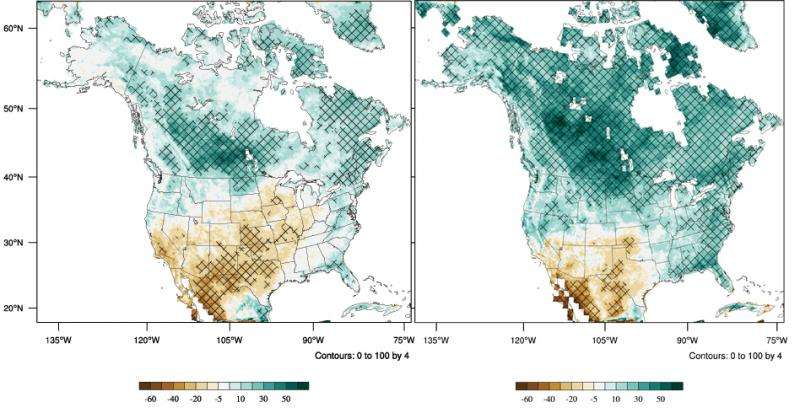(Rain)cloud computing: Researchers work to improve how we predict climate change

Rao Kotamarthi and Jiali Wang spend their days looking at a future Earth.
At the U.S. Department of Energy's (DOE) Argonne National Laboratory, the two scientists work on simulations and techniques to project what the climate will look like 100 years from now.
Last year, they completed the highest-resolution climate forecast ever done for North America, dividing the continent into squares just over seven miles on a side—far more detailed than the standard 30 to 60 miles.
Adding more resolution to climate models is extremely computationally intensive, like working with a video file containing every minute of your life instead of just every birthday. But the added accuracy is worth the extra computational cost, they said.
"In particular, places with sharp terrain changes, like the Rockies, saw big improvements," said Kotamarthi, who heads the department of atmospheric science and climate in Argonne's environmental science division.
In all, Kotamarthi said, the model's bias—found by having the model "predict" the climate for the past 30 years and then comparing it with the actual recorded weather—was much improved over a lower-resolution model.
The model was also better at predicting seasonal features, like Southwestern monsoons. The simulation predicted less rain over the Southwest but more on the eastern seaboard and much of Canada. These effects intensify later in the century.
"By far the largest uncertainty in a climate model is the water cycle," said Wang, an Argonne postdoctoral researcher. According to Wang, a higher-resolution model targets that issue. Scientists noticed a bias in their models that always seemed to make the Northern Great Plains wetter than it actually was; the higher-resolution reduced the bias, and preliminary results for an upcoming even higher-resolution run lower it by nearly a third, she said.
In addition, the data itself has a multitude of uses. For example, regional and city planners want to know how their local climates might change, so they can build roads to withstand more flooding or plant street trees that can handle more heat. The tighter resolution can help provide those regional predictions.
Other teams are already using the dataset to analyze particular areas: a group with Purdue University is modeling the agricultural impact on Midwest corn and soybean crops, for example, and University of Chicago researcher Colin Kyle is using the data to study how the range of a fungal pathogen that kills invasive gypsy moths might expand or contract in the future.
The dataset will be online shortly for anyone to download, Wang and Kotamarthi said. (It's hundreds of terabytes).
In a study just released with researchers from University of Chicago and Purdue, Wang and Kotamarthi explored a new method for calculating the likelihood of extreme weather events. Extreme events, such as severe thunderstorms or number of days with extreme heat, represent a serious threat of climate change—the worst storms will cause the most damage—but because models with large grid sizes are smoothed out over large spaces and often time, there's been suspicion that they aren't good at predicting infrequent events like disastrous storms.
Their new method, designed specifically for looking at chunks of the model rather than the entire US, was better at predicting days with extreme heat than conventional techniques, they said. It should add accuracy for other extremes, like precipitation, as well.
Next, Kotamarthi and Wang aim to improve their models' resolution even further. "For our next task, we want to tackle a two-and-a-half mile resolution," Kotamarthi said. "This is small enough to capture physical phenomena, like convection in the atmosphere." Convection refers to the vertical movement of heat and moisture in the atmosphere.
And locally—what will happen to Chicago in 2050?
"Like much of the eastern half of the country, our model predicted that overall precipitation in the Midwest would go up," Kotamarthi said.
The results of the high-resolution models are published in the open-access journal Earth's Future in the study "High-resolution dynamically downscaled projections of precipitation in the mid and late 21st century over North America." The study on extremes is titled "Evaluation of dynamically downscaled extreme temperature using a spatially-aggregated generalized extreme value (GEV) model" and was published in Climate Dynamics with co-authors Yuefeng Han and Michael Stein at the University of Chicago and Whitney K. Huang at Purdue.
The research was funded by the U.S. Department of Defense's Strategic Environmental Research and Development Program. Computational resources came from the Argonne Leadership Computing Facility and the National Energy Research Scientific Computing Center at Lawrence Berkeley National Laboratory, both DOE Office of Science User Facilities.
More information: Jiali Wang et al. Evaluation of dynamically downscaled extreme temperature using a spatially-aggregated generalized extreme value (GEV) model, Climate Dynamics (2016). DOI: 10.1007/s00382-016-3000-3
Journal information: Climate Dynamics
Provided by Argonne National Laboratory




















